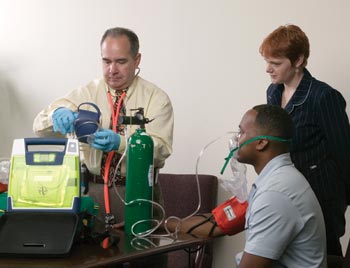The business of taking care Focus on employee well-being and safety leads to better response and recovery during crises By John Chivvis Simply put, employees want to feel safe at work. According to the Society for Human Resource Management’s (SHRM’s) “2005 Job Satisfaction Survey Report,” employees in every age bracket chose “feeling safe” as one of their top five qualifications for job satisfaction. Providing a safe work environment means developing and implementing plans and programs to cope with any level of disaster or crisis. Agencies such as the Santa Monica, California-based Sander A. Kessler & Associates, Inc., and the Dallas, Texas-based McQueary Henry Bowles Troy, LLP (MHBT) take that charge very seriously, each having implemented successful solutions to enhance employee safety. Evacuation events At Kessler & Associates, part of their disaster recovery plan includes a comprehensive protocol and evacuation procedure for their office of 85 employees. They’re in good company, according to the “2005 Disaster Preparedness Survey Report” from SHRM that reported that 99% of organizations have some form of fire or evacuation plan in place. What makes Kessler & Associates’ evacuation procedures impressive is the fact that it’s not just a plan—it’s a culture. “Sixty-five percent of what we write is workers comp,” says CEO Steve Kessler. “We live, breathe, and preach safety, so I guess you can say we invest heavily in it.” Building the concept of culture requires information and the right tools. With cubicles seeming mazelike, HR Director Gail Cowan says that each employee starts off by being given a laminated sheet with an evacuation map with exits and stairwells highlighted. “Each associate has designated duties in the event we have to evacuate the building,” explains Kessler, whose duty is “floor warden.” He walks the floors to make sure all employees have evacuated. Employees are delegated tasks that include helping disabled employees, clearing out stairwells on the way out, performing roll calls, and hauling out the earthquake-ready first-aid kits. Cowan says each department delegates two representatives for their emergency response team. Members of the team meet regularly with building security to discuss evacuation plans. They are trained in first aid and CPR, as well as in the proper use of the agency’s heart defibrillator (also known as an automated external defibrillator or AED), and building fire extinguishers. Beyond agency communication and employee involvement, a viable safety culture requires commitment and reinforcement, because out of the aforementioned 99% of organizations with the fire/evacuation plan, only 36% actually conduct regular fire drills.
That’s not the case at Kessler & Associates. Practice is a serious matter, so twice a year fire drills are conducted. When the call comes over the intercom that a fire drill is underway, employees evacuate to a location in the parking lot 75 yards from the building where Cowan and safety team members begin the roll call and head count. Says Kessler, “Even if an associate happens to be on the phone with a customer when the drill is announced, they tell their customer that they have to get off the phone.” Other exercises are also conducted to help employees enhance their safety knowledge. Cowan says that one exercise they use is to ask employees to pretend they are called to evacuate. They are told, “We need to get out. What would you grab to take with you?” and answers are discussed. “It’s these kinds of exercises that help you realize how you should react in these kinds of situations,” says Cowan. “We—leadership, management, and our associates—are committed to these drills,” says Cowan. “In the case of a fire or similar event, we want our associates to be able to react and not panic because they know what to do. They don’t have time to freeze.” Medical emergencies Feeling safe is not just about fires and evacuations. It’s about being prepared for medical emergencies. While the “Disaster Preparedness Survey Report” notes that most organizations provide some type of training (such as CPR, first aid, and crisis response), few have had the success of MHBT’s Medical Emergency Response Team (MERT). Brian Gardner, senior vice president of account services, consulting and coordination for MHBT says that the MERT program began in response to safety issues that he perceived the agency had. As a part-time firefighter and licensed medic, Gardner’s recertification as a medical technician made him realize that MHBT didn’t have any kind of response team. “We had a leftover oxygen tank and a first-aid kit that had some aspirin and a few Band-Aids®, but nothing to address anything life threatening,” says Gardner. Gardner put together a proposal that would not only get the equipment they needed, but also the training to use it. He acquired a proper oxygen kit, and the first-aid kit now includes a host of medicines which Gardner (as a medic) is licensed to administer. They also purchased three AEDs and now have their own CPR mannequins. After training MHBT employees in CPR techniques and in the use of the AEDs, Gardner formed the first emergency response team. Soon, though, they were getting requests for assistance from other tenants as well as from property management. “We had a medical event happen on another floor, and building security asked us to assist,” says Gardner. “That led us to put together something even more formalized.” Doug Laing, property manager for McKnight Property Management—the owners of the property and an MHBT client—and Gardner worked out a plan to make the MERT available to the more than 30 businesses that occupy the property in two buildings (four stories and 21 stories high) as well as personnel involved in current “build-outs.” Gardner now offers training and certification to all of Laing’s building operations and security personnel, new tenants, and build-out construction managers and supervisors. In return, McKnight has underwritten some of their supplies and resources. Today when a medical event occurs, the procedure is to call 911 first, then call the MERT, and the property manager. “Ambulance response times in Dallas-Fort Worth can vary between seven and twenty minutes,” notes Gardner “and without adequate response and oxygen, the threat of permanent brain damage can start in as little as four to six minutes.” Laing calls the program an “incredible amenity” adding, “We feel very blessed to have a medical response team available on site to provide assistance.” From training MERT members and other employees, Gardner sees exactly how knowledge and training empowers people. The “Disaster Preparedness Survey Report” findings note that for employees responsible and trained for specific tasks, “… almost all felt adequately prepared to take a leadership role in the event of a disaster or emergency.” Gardner says, “I’ve seen it happen first hand. After the first couple of calls, a couple of employees said they wanted to resign from the team, but as they’ve had more training and we’ve had more and more calls, they’ve become more and more confident. And that’s important, because even though I’m here 90% of the time, our team needs to be ready 100% of the time, and that requires their getting involved in events where they can use their training.” Based on the feedback and success of the program, MHBT and Gardner are now looking at ways to offer the training and safety services to their clients. “We’re looking to see if it would be a good fit with our Construction Practice Group and their ‘client service toolbox’ for construction clients,” says Gardner. “As a value-added service to our traditional risk management services, we can add American Red Cross CPR training; it’s just another brick in the wall when building relationships between MHBT and our clients.” Employee value “One of the errors in crisis management planning is the tendency to focus on systems, operations, infrastructure, and public relations, with people last on the list,” writes HR content expert Nancy Lockwood in “Crisis Management in Today’s Business Environment: HR’s Strategic Role.” “Organizations need to pay greater attention to the impact of critical events on employees, their families, and the community.” At Kessler & Associates and MHBT, their respective plans and programs are extensions of the agency mission and mindset. “We’ve always been involved in helping others in need; we’re very family-oriented,” says Gardner. “Understanding the human element, in areas such as life safety,” Kessler adds, “has helped us to do what’s necessary to take care of our employees.” * Editor’s note: Next month, John Chivvis will continue his examina-tion of business continuity planning with tips from a recovery solutions provider and insights from an agent who has put some of those ideas into practice. |
||||||
|




